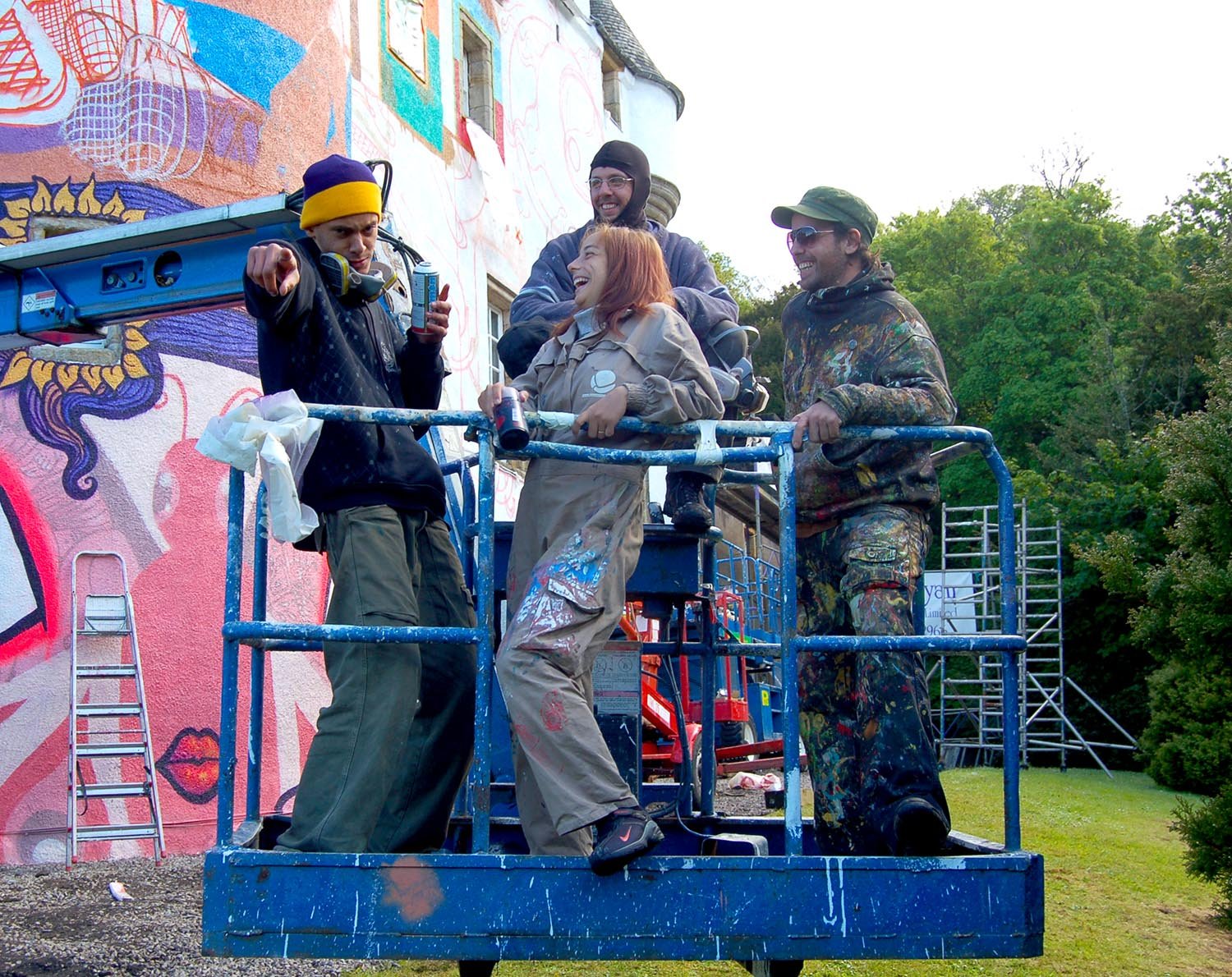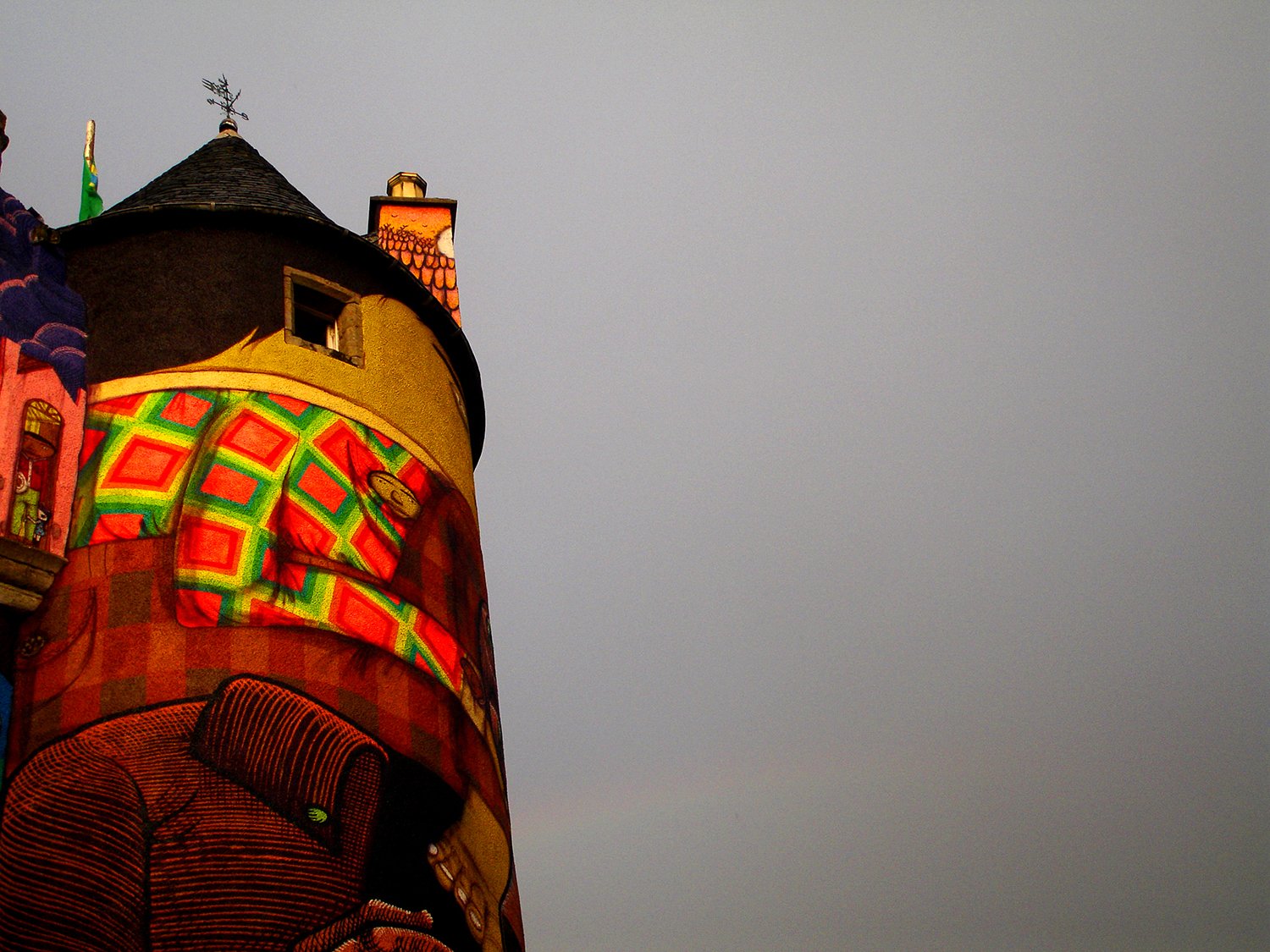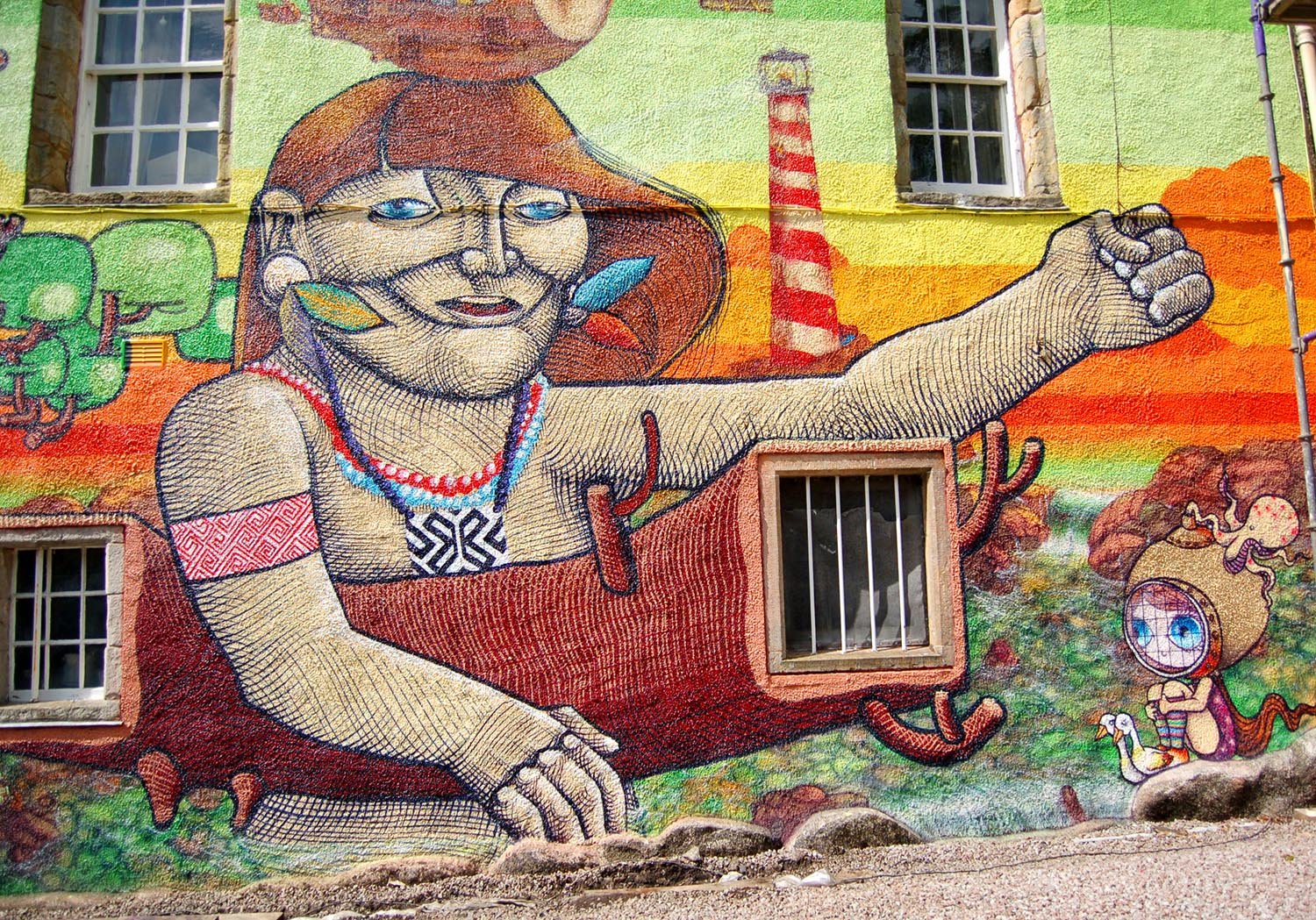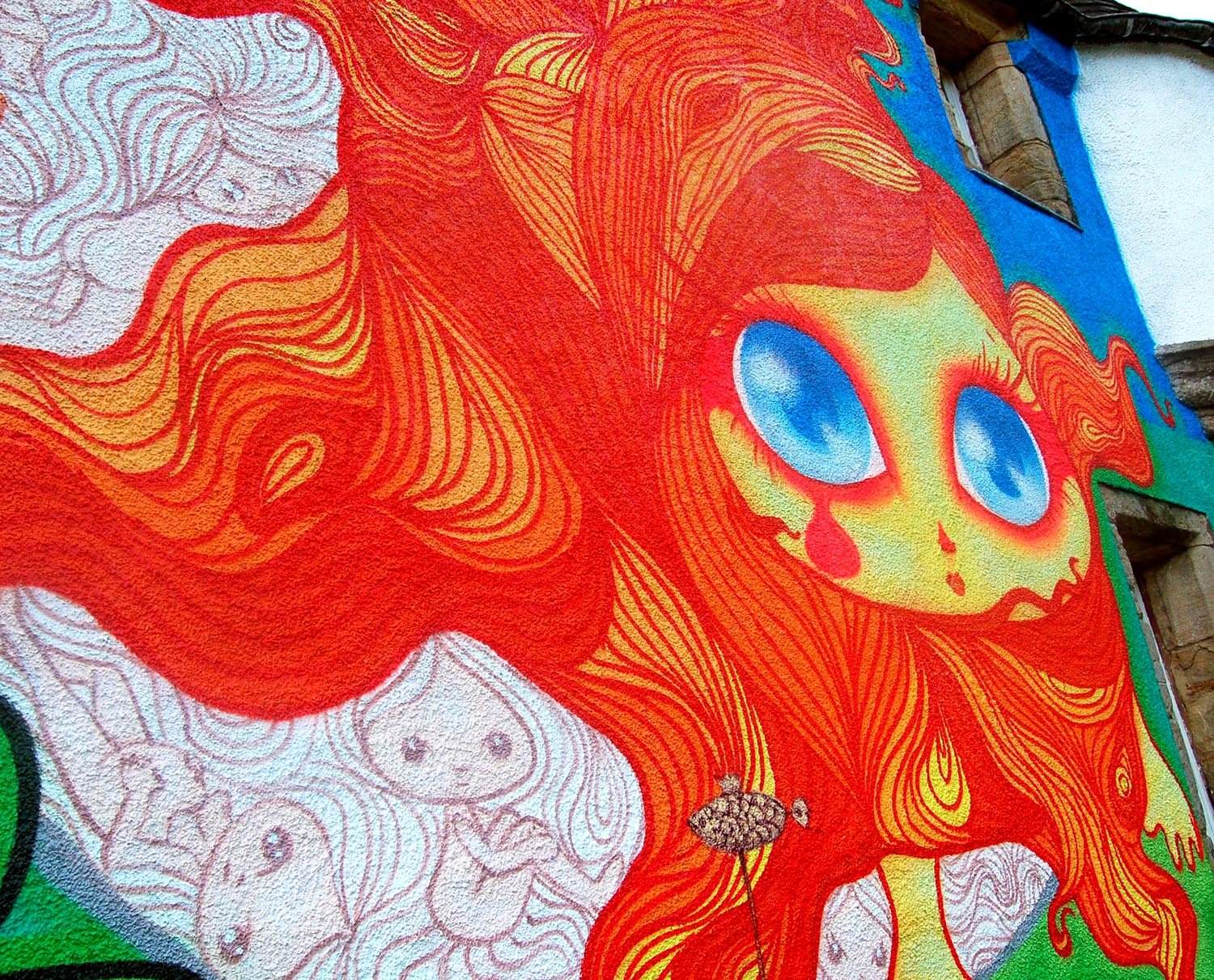The Graffiti Project
Kelburn Castle - 2006 - Artist’s in residence
The Idea was simple......We took the vibrant and often transient art form of Brazilian graffiti out of its predominantly urban context and applied it to the ancient and permanent walls of an historic rural castle in Scotland. The project involved four leading Brazilian graffiti artists from Sao Paulo being employed to cover the entire south façade of the two oldest towers (1200 and 1580) with 1000 cans of spray paint.
It was intended to be controversial and to challenge the established art world and it was successful beyond all expectations. The project involved the artists and organisers living together in the Castle for approximately one month. It was a project of contrasts and collaboration, that bridged between cultures, rural and urban realms and united two proud and very different countries.
Castle walls being primed quickly before the artist’s arrived in scotland
The Image of the white primer being applied to the walls encapsulates the exact time I thought to myself, 'Oh my God, It is actually going to happen'. Before this time, even though we had been working on the project for months, there was always something inside me that thought 'someone will have to stop us soon'. Even though we had paid for the artists plane fares and managed to get the BBC television Culture Show to begin to film the process it was not until this point that it became real. It was also the time that in my mind, people actually started to take the project seriously. Ideas that were discussed in the pub about three years before were actually materializing.
Three Directors and four Artists
Ist Promo Image
Karen Brown filming Lord Glasgow for the Culture Show
My Brother David, my close friend Camilla and I, were the directors of the project. We had obviously never done anything like this before so we had no rules to go by, only a mass of contradictory advice from many people who may or may not have had any experience of doing such projects. We had to go with our gut instinct in regards to the way we ran it; which is one of the reasons I think the press took such an interest in the idea. We were three enthusiastic creative’s just out of university who had an unique idea, who were determined to get the project done. We were told by the Scottish Arts Council that we had left everything too late for succeeding in a project of this scale let alone, securing any funding. But we had to do the it then; for we knew we would never all be free together, and at the same time as the castle was due for major renovation which would include future removal of the graffiti. It was now or never.
Nunca, Nina and Os Gemeos
Security on site
Lord Glasgow meeting the artist’s for the 1st time
After I had booked the artists plane fares and agreed with them their payment for the project, we realised we did not have enough money. We had to make some money extremely quickly and this had to be the priority, even though there was still so much to do before the Artists arrived. My brother and I went into our local town with a clipboard and cold-called many of the local businesses. We offered them, for a fixed fee, a space for their logo in the local paper along side a feature about the project; advertising space on our website that was now averaging over five thousand hits a day and an invitation to the private view a month later.
After a lot of coaxing and explanation about all the local benefits the project would bring to the community, we had many businesses onboard. We had our fare share of people look at us in disgust, in disbelief that such a project could even go ahead. “It's vandalism, it’s a disgrace”. Luckily, we could say confidently to these people that Historic Scotland and the Historic Houses Association were backing the project 100%. When the project was over we had a few people come up to us, offended that we had not asked them for sponsorship.
A project of contrasts
Artist’s planning their creative collaboration
Two days before the artists arrived, I received an e-mail from them asking us if we had primed the walls yet. We now realise how ignorant we had been not to have thought of this but it really had not crossed our minds with everything else that had been going on. We had to prime over 350m² of Castle wall with white emulsion, ASAP. Our friends from Largs agreed to come up and help us paint the walls, but we could only get the cherry picker and Scissor lift to come one day early. We were all still painting late into the evening the night before we picked up the artists from the airport. We were so glad that we had remembered to raise the Scottish and Brazilian flag above the turrets, as it was one of the many details, the artists said made them feel so welcome.
West coast light making the colours golden
Os Gemeos brother’s work intuitively together
The artists integrate their characters
Nina Pandolfo - work in progress
Kelburn Castle - Winter 2009
The light on the west coast of Scotland is renowned for its drama and beauty. It can be so intense that the atmosphere is fantastical and sometimes surreal. This feature was one of the primary aspects that got us so energised about the project. We kept on saying to each other, “Can you imagine what it would look like on a dark thunderous day, or in the winter when the landscape is completely covered in snow, or when a golden light is coming in from the west. It is going to look crazy”. Every time I go home, I still get an elated feeling that my family home is actually multicoloured. I feel privileged to see the vibrancy of the animated characters in their supernatural world in such a variety of truly magical and emotional lights. As a whole the artwork bowls one over but its in the details where you can explore the artists imaginations.
Nunca’s artwork with Nina’s character to the right
Os Gemeos
Nina Pandolfo - The Sun and Moon united
Everyone was extremely nervous when we all met for the first time, after all we were all going to have to live together. We gave them haggis for their first dinner and bag piped them to their seats. ‘Ode to a haggis’, by Robert Burns was recited before the haggis was cut open. This really confused the artists, but we felt this was necessary in order to give them a traditional Scottish welcome. We also introduced them to Irn Bru, whiskey, and proper fish supper. When we first proposed ‘The Graffiti Project’, to the artists, we promised that the project would also be good fun, all living together and getting to know each other at Kelburn Country Estate and Castle. We organised parties and meals and, best of all, Sambayabamba, a 20 + samba, drumming and percussion band from Glasgow who played three times throughout the artists’ stay who created a feeling of celebration.
Looking down the castle’s tower
Sambayabamba
Looking up the Castle’s Tower at night
The artists never gave away what they were going to paint on the walls. They wanted it to be a surprise for everyone. Most of us working on the project were in the office dealing with press, marketing, sponsorship and admin and so it was exciting to see what new character or scene had appeared since the last break. Os Gemeos means, ‘Twins’, in Portuguese; Otavio and Gustavo are identical twin brothers who work on their art instinctively together. It was amazing to see how naturally they all worked together. Many of their characters crossed over and appeared in each other’s sections. Some parts would be started by one artist, then finished off by another. We all felt very privileged to see this first hand. A young man came all the way from Canada just to see them work; he proclaimed that the purity of their imaginations was unequaled.
Original time lapse by Elliot Thompson
By about half way through the project we were getting a lot of press attention. Our father who had always been a bit dubious of the project, was, by this stage, obviously as excited as we were. He just could not believe the project featured in a double page, colour, middle page spread in the Guardian and on the BBC Breakfast Show; It was a dawn start for all of us as the crew filmed live from Kelburn. A representative from Globo Television (South America’s most established television company) came and filmed at Kelburn which was then broadcast to over one hundred and twenty million viewers all over South America, adding to the artists' celebrity status. Karen Brown who had been filming on behalf of the Culture Show right from the beginning made a beautiful 7-minute piece, which captured the atmosphere of the project perfectly.
Emotional speeches were made at the Private View
Kelburn Castle - A Brazilian Makeover
The artists finished the painting after only twenty days work. Everyone was unbelievably pleased with the outcome. The artists had incorporated Scottish elements onto the walls, with blue eyed and pale-skinned characters, tartan trousers and figures playing the pipes. The rather dour, grey and depressing cement render had been transformed into the most uplifting and controversial façade in Britain. Not only have we all gained an infinite amount of knowledge and experience, from doing, ‘The Graffiti Project’; we have all become lasting friends and been introduced to another culture. If you have enough faith in your idea and enthusiasm to portray your vision to others no matter how little experience you have, I believe you can always find a way.






















